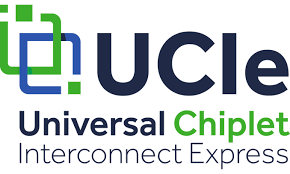
UCIe (Universal Chiplet Interconnect Express) is an open industry standard for die-to-die interconnects that enables high-bandwidth, low-latency, power-efficient communication between chiplets in advanced package architectures. The UCIe specification was launched in March 2022 by the UCIe Consortium, with founding members including Intel, AMD, TSMC, Samsung, Arm, ASE, Google Cloud, Microsoft, and others.
UCIe aims to establish a universal, interoperable ecosystem for chiplet-based designs—similar to how PCIe transformed board-level device communication. By standardizing the physical layer (PHY), protocol stack, software model, and compliance requirements, UCIe allows chiplets designed by different vendors and process nodes to interoperate within a common package.
Why UCIe Matters
As Moore’s Law slows and monolithic SoCs become more costly and complex, the semiconductor industry is shifting toward chiplet architectures—modular silicon blocks that can be manufactured separately, optimized independently, and assembled into a system-in-package (SiP).
Before UCIe, most chiplet integrations relied on proprietary or custom interconnects (e.g., AMD Infinity Fabric, Intel AIB, Nvidia NVLink). These limited interoperability, increased cost, and required tight coordination between die teams.
UCIe addresses these challenges by:
-
Enabling multi-vendor chiplet ecosystems
-
Allowing reuse across nodes, fabs, IP, and design houses
-
Reducing design time, risk, and cost
-
Supporting integration across heterogeneous compute, memory, I/O, and acceleration
Key Features of UCIe
| Feature | Description |
|---|---|
| Open Standard | Managed by the UCIe Consortium; royalty-free |
| Die-to-Die Interconnect | High-speed links for short-range intra-package communication |
| PHY Layer | Support for advanced package integration: organic substrate, silicon interposer, or hybrid bonding |
| Protocol Layer | Defined transport, flow control, and error handling mechanisms |
| Software Layer | Compatible with existing PCIe and CXL software stacks |
| Power Efficiency | Energy-optimized interconnect for mobile, AI, and HPC |
| Scalability | Supports thousands of interconnect lanes and multi-terabit throughput |
UCIe Architecture
UCIe defines a full-stack framework for chiplet communication:
1. Physical Layer (PHY)
-
Supports multiple integration modes:
-
Organic substrate (lower bandwidth, lower cost)
-
Silicon interposer (CoWoS®, EMIB)
-
Advanced hybrid bonding (e.g., SoIC™)
-
-
Supports single-ended and differential signaling
-
Link widths scale from x4 to x256+ lanes
2. Protocol Layer
-
Based on a lightweight protocol stack
-
Includes flow control, lane bonding, error correction
-
Can transport:
-
PCI Express (PCIe)
-
Compute Express Link (CXL)
-
Custom protocols
-
3. Software Layer
-
Designed to be transparent to software
-
Compatible with existing driver stacks
-
Enables plug-and-play chiplet interoperability
UCIe Integration Modes
| Mode | Packaging Type | Data Rate | Use Cases |
|---|---|---|---|
| Standard UCIe | Organic substrate | ~16-32 Gbps/lane | Cost-effective integration |
| Advanced UCIe | Interposer or hybrid bonding | Up to 64+ Gbps/lane | High-performance chiplets |
Each mode trades off performance, cost, and complexity depending on application needs.
UCIe Use Cases
-
AI and Machine Learning Accelerators
-
HPC processors with chiplet-based architectures
-
Heterogeneous compute: CPU + GPU + NPU
-
Disaggregated memory systems
-
CXL-based memory expansion
-
Modular SoCs for automotive and edge
UCIe vs. Other Technologies
| Interconnect | Type | Vendor | Open Standard | Interop |
|---|---|---|---|---|
| UCIe | Die-to-die | Consortium | ✅ Yes | ✅ Yes |
| AIB | Die-to-die | Intel | ❌ No | ❌ No |
| Infinity Fabric | Die-to-die | AMD | ❌ No | ❌ No |
| NVLink | Board-level & package | Nvidia | ❌ No | ❌ No |
| PCIe | Board-level | PCI-SIG | ✅ Yes | ✅ Yes |
| CXL | Board-level | CXL Consortium | ✅ Yes | ✅ Yes |
UCIe is the first open standard to enable true chiplet interoperability across vendors and ecosystems.
UCIe Consortium
Formed in 2022, the UCIe Consortium oversees the evolution, adoption, and compliance of the standard. Its membership spans across:
-
Foundries: TSMC, Intel, Samsung
-
IP providers: Arm, Synopsys
-
System integrators: AMD, Nvidia, MediaTek
-
Cloud/AI players: Microsoft, Google Cloud, Meta
-
Packaging houses: ASE, Amkor
-
EDA vendors: Cadence, Synopsys, Siemens
The consortium released:
-
UCIe 1.0 in March 2022
-
UCIe 1.1 in 2023, with enhanced support for multiple protocol tunnels
-
Future versions will support chiplet discovery, security, and energy-aware routing
UCIe and the Future of Chiplets
UCIe is a cornerstone for the chiplet economy, enabling:
-
IP disaggregation and modular SoC assembly
-
Commercial chiplet marketplaces
-
Design reuse across process nodes and vendors
-
Integration of analog, RF, photonics, and AI engines
-
3D IC systems built from chiplet building blocks
Also Read:
Share this post via:














Quantum Computing Technologies and Challenges